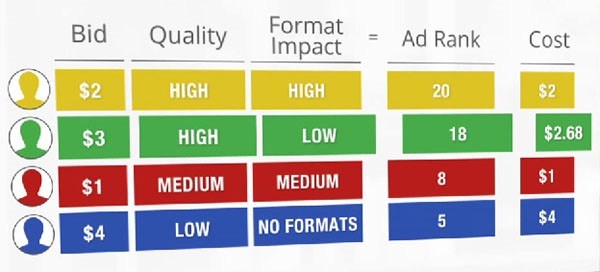
By Christian Hardy
As a Paid Search Specialist, I get asked all the time, “What is Google Ads? How does it work?” This is a pretty complex question, so let’s break it down.
In this post we’ll learn about two underlying components that determine how Google serves ads to their advertisers using a piece of technology created in the 1950s and a special kind of auction that was invented in the 1960s. We’ll explore some of the hidden details behind Google Ads, get the gist of what a Vickery auction is, and we’ll learn how advertisers utilize the exploration/exploitation trade-off of Google’s Vickery auction to turn clicks into customers.
Google’s Search Engine and Google Ads
Internet search engines like Google and Microsoft’s Bing receive revenue from ads shown to users searching for specific keywords, so it’s in the search engine’s best interest to display ads that are most relevant to a user’s query in hopes of increasing the chance of a click.
When a person decides to click on an ad displayed because of a keyword in their search…

…the advertiser pays the search engine.
In order to serve the most relevant ads to users, Google Ads learns which ads are the most relevant to display for different queries over time. It learns how to do this by exploiting the keywords you use, showing you an ad on the search engine relevant to your keywords and exploring your search history over time to learn which ads would be potentially relevant to you.
The Technology
This problem of matching ads to different ad positions can be framed using a concept from probability theory known as the multi-armed bandit (MAB) problem, which is a classic, foundational machine learning concept used by large search engines to display search ads. Simply put, the goal of the MAB algorithm is to match competing advertisers to different positions on the search engine results page based on a number of features summarized into a metric called “ad rank.” Ad Rank executes positive and negative reinforcements on a Google Ads account based on the account’s ad rank value. So even though our green advertiser is willing to pay more for a click than our yellow advertiser, the green advertiser will not win the auction because his ad rank is lower than the yellow advertisers.

It’s safe to say the way Google and Microsoft use multi-armed bandits has been abstracted over the years, but the idea has certainly laid the groundwork for turning multi-billion-dollar paid search advertising platforms into digital Vickery auctions.
The Auction
In a live Vickery auction, bidders submit bids without knowing the bid of the other people in the auction. Or in the case of a Google Ads account, advertisers submit a bid for a keyword they’re targeting without knowing the bid of the other advertisers in the auction and they’re both competing for the same ad positions. This is also known as a second price sealed-bid auction, because the highest bidder wins but the price paid is the second highest bid. This type of auction awards the advertiser with the highest bid but sells the ad position to the advertiser with the highest ad rank at the price of the second highest bid. So, Google’s auction design allows us to only pay our maximum willingness to pay for a click which translates to us paying just enough to beat the competition, which helps us save money!
Today and more than ever, PPC advertising is a no-brainer if you want your services to be found online. But the world of PPC is moving very fast right now with new tools and strategies being developed on a near monthly basis. Making sure your accounts are managed by expert specialists who are embracing the innovations and are up to date on the impact of PPC automation should be your #1 paid search goal.
About the Author
Christian Hardy is a Paid Search Specialist for ChoiceLocal. He runs Google and Microsoft ad campaigns. When he’s not analyzing PPC data he enjoys rollerblading, working on motorcycles/mopeds with friends, listening to music and spending time with family.
Resources:

